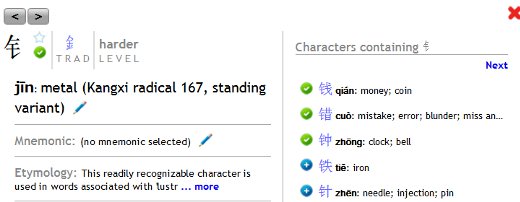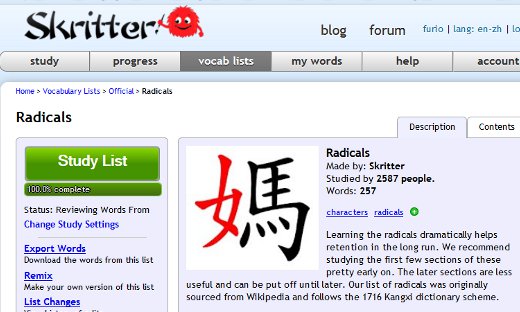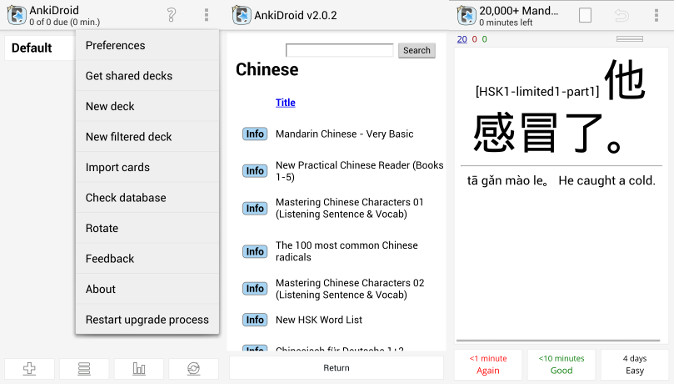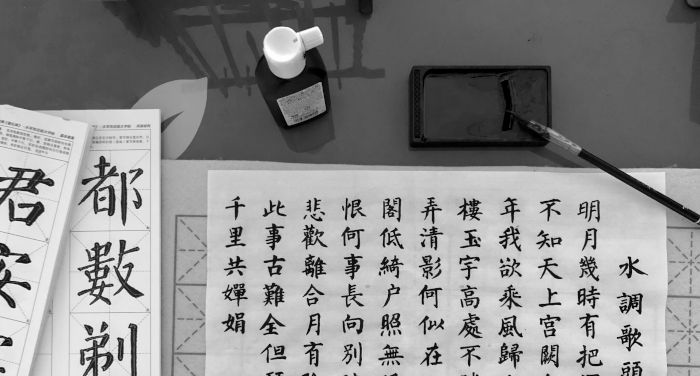Today I want to show you how taking the time to learn the 256 Chinese radicals (that is the basic components of any Chinese character) will allow you to learn Chinese characters much faster. I will do it through a real life experience (no worries, you won’t hear any overly complicated or abstract theories here!)
Just to recap my situation, on February 2013 I’ve started to learn how to write Chinese characters using Skritter, an interactive software that allows you to learn characters faster by reviewing flashcards with a clever scheduling (click on the link if you want to understand how it works).
My goals were to:
- Add new flashcards and review old flashcards for a total of ten minutes per day.
- Using mnemonics to actively study the characters that I can’t remember (instead of trying to remember them by reviewing them over and over again).
- Study all the characters and words of the HSK lists from HSK1 to HSK4, that is 1076 characters and about 700 words composed by the same characters.
Where am I?
Using Skritter about ten minutes per day I was able to learn all the characters of the first three levels of the HSK and I’m now going through level 4, the last one I’m supposed to study. In particular, I’ve already learned 830 characters and 420 words.
At the moment I live in Shanghai, where both my girl and all my friends are fluent in English, and I speak Mandarin much less than when I was living in Hangzhou (where English is less common).
However I feel that studying the characters helps me to remember what I already know and improve the quality of my life as I can now reading in a more effective way and understand a lot of documents that before were a no go for me (bills, long text messages, food menus and so on).
The fastest way to learn new characters
I think everybody will agree with me when I claim that the fastest way to memorize new characters is to decompose them on their main components and connect these components together to somehow convey the meaning and the shape of the characters you want to learn. You can find several examples by watching the video at the beginning of this post (it’s funny, watch it!).
The problem I was facing
Ok, if I know that the character 木 means “tree,” then it will be easy for me to remember that the character 森 means “forest.” After all I see a bunch of trees so it makes sense!
However it’s not always that easy. Let’s take another fairly common word, 分钟, which means “minute.” I was able to identify three main components, that is 八 (it means “eight”), 刀 (it means “knife”) and 中 (it means “center”).
Unfortunately I had no idea about the left part of the character 钟. Thus I firstly came up with the following mnemonic:
“It takes a minute (分钟) to divide an hook at the center (钟) into eight knives (分).”
But I wasn’t satisfied. Not at all! This is clearly too messy and almost impossible to remember. Also, I choose the trigger “hook” because the left part of the character 钟 remembered me the shape of an hook (钅). But this isn’t its real meaning, so the process isn’t scalable. Or, in other words, I can’t effectively re-use the trigger hook for remembering different words.
 钅 jīn: metal (Kangxi radical 167, standing variant)
钅 jīn: metal (Kangxi radical 167, standing variant)
I then took a second to dig on to Skritter’s database and I found out that 钅 was a variant for 金, which is a character I know quite well (it means “metal” or “gold”).
Now that I knew ALL the four components of the word 分钟 the situation changed. Fist at all, I was able to find an easier mnemonic, that is:
“Eight metal knives on the quadrant (that is the center) of a watch.”
Why this mnemonic is easier than the previous?
Because the first mnemonic was a non-sense story. And stories are long and difficult to remember. Conversely, the second mnemonic is an image, that is a watch with eight metal knives as minutes hands of the quadrant, namely the center, of a watch.
Moreover, when I already know ALL the components of a word, I often don’t need any mnemonic to remember the word as I’m already familiar with the shape, meaning and pronunciation of each component.
Despite what people may think, Mandarin has a logic and in most of cases the meaning and pronunciation of at least a component will trigger the meaning and pronunciation of the whole word.
As an example, the character 钟 is pronounced zhōng as the character 中.
What this taught to me?
The journey to learn how to write the word 分钟 taught me that it would be much easier for me to learn Chinese characters if I could just know ALL the basic components, which are called radicals.
I never took the time to learn radicals in the past because many of them are only used as components of more complicated words. Moreover, I thought there were thousand of radicals to learn!
Out of curiosity, I checked the Skritter’s Radicals deck and I discovered that Mandarin only has 216 radicals, which become 256 if you take into account the different variants of some radicals. To stick to our example, 钅and 金 represent the same radical when used in different positions (see the characters 钟 and 鑫 for a graphical explanation).
 Skritter’s deck of Chinese radicals
Skritter’s deck of Chinese radicals
So I decided to learn the radicals
This mayor discovery took place on March the 10. I then decided to stop learning the HSK decks and focus on learning the radicals for awhile. It took me about three weeks to learn all the 256 radicals, at the pace of ten minutes per day, before to come back to my HSK decks.
I believe this was a great “investment” because now I recognize the basic components of ANY Chinese character, I can come up with a good mnemonic faster and learn complex characters became (relatively) easier.
I say relatively because there are still a lot of characters that challenge me (餐 for instance) for the simple reason that they contain a lot of radicals. However now I know how to decompose them on components I’m familiar with. So no character scares me me anymore ; )




Hi Furio
Interesting post. It looks a little to me like you’ve independently ‘discovered’ the Heisig method. (And a number of people have – like the video you show above – that it’s even a little cheeky for me to call it the Heisig method :-) But that’s the approach I have taken.)
You are right that focusing on the radicals creates a series basic steps – and if people can write and ‘picture’ those, then they’re on the right track! I think what Heisig adds to this is two-fold:
– He makes it simple to visualise difficult characters. 白 is easy to see, but it’s hard to attach to images. Heisig suggests for example to picture a white dove. That makes things a lot easier – and his system is filled with examples like this.
– Some characters are made up of several components, like 蓉. It would be a rather complex image/story to remember that 蓉=艹+宀+八+人+口. So Heisig builds up stories with increasing complexity (although still a really simple image) … so that eventually you just have 蓉=艹+容 (because you’ve already learned, for example, that 容=宀+谷, and you already know that 谷=八+人+口, etc.)
Similarly, 餐 is a difficult example, as you point out, when breaking it down into pieces. But if you already have images for 卜 & 夕 & 又 & 食 … then it’s easy to do. And you don’t have to try to hard with 食, because although it is made up of other pieces, the system, already teaches you an image for that entire character, and that’s enough to recall in an instant.
Hope what I wrote makes sense. And again, I agree totally about what you wrote, if you get the pieces right, then doing the built-up character is much easier!
Hey Greg,
yeah the video wasn’t intended to people like you. But I think it’s interesting for beginners and, as for many TED talks, the graphic/presentation is high level.
Personally I don’t think that the “novelty” of Hesig method are mnemonics (which are known since thousands of years) while a complete streamlined process to learn Chinese characters.
As you know from our past discussion on the topic I’m not a big fan of Heisig method for the simple reason that it didn’t click for me (even if from a theoretical point of view is an awesome concept).
I think the reason it didn’t work for me is that Heisig method is a bit “overkilling.” I mean, there are many characters for which I don’t really need mnemonics cause I’ll just remember them on the spot. For others, often write them once or twice will do the trick. I estimate I use mnemonics only for the 20% of words (I prefer to talk about words cause many of the characters I’m learning are embedded into 2 or 3 characters words that I can use on everyday life).
But yeah, the general idea is that if you do some homework beforehand (learning the radicals for instance) then you will see huge benefit on the longterm. I guess that following the Heisig method you just have to do more homeworks AND you will get more longterm benefits for it.
On a side note, it’s funny how I used the character 餐 as an example of difficult character but then I found it so easy to remember cause I know 食, which looks difficult but it’s fairly common, and the rest is just some symmetric easy stuff to remember (食 with two ears haha).
So this is a classical example of overkilling by using mnemonics cause build a story/image for the whole set卜 & 夕 & 又 & 食 would have required me some work while in fact I discover that I didn’t need it at all!
Hi again Furio – always enjoy discussing with you :-)
I agree that Heisig isn’t about the novelty of it. What he does it turn it into an easy-to-swallow system, like using ‘white dove’ to represent 白, and not just ‘white’, like differentiating between ‘swim’ and ‘go swimming’, etc. images are clear and relatively distinct, so that hard work has been done, we just have to visualise.
Again, if it’s overkill for you, then agree not to use it. There was about 3 years between when I learned Book 1, and when I went through it a second time – and that taught me a lot about what really works. I wrote about it in Bad Heisig images & great Dali paintings. One of my realisations that I mention is that even though I thought I knew characters and so didn’t have to do images for them, when 3 years have passed, actually ‘just knowing’ can fade, and without an image to fall back on, the character was basically useless to me.
* When I started Book 1, I would say I could recognise less than 100 characters without needing an image.
* Right when I finished the book after 3 months, I could probably instantaneously recognise 300-400, and I needed images with 1100+ of them.
* Three years later, and this is a total guess, I could instantly recognise half the characters in the book (the ones that were commonly seen) without thought, but still used stories – which by that stage took a fraction of a second to picture – for the remaining half
Obviously the goal is to have instantaneous recognition of all 3000 characters that I will know by the end of this year, but I know for a fact that that won’t happen – especially with the uncommon ones. But I will always have the stories, so I will be able to reach ALL of them, even if some take a fraction of a second longer :-)
Yup, I read the article!
You are spot on when you claim that many people make the mistake of creating “sentences” instead “images” to visualize.
Now my question for you (provocation? hehe) is:
Why do you have the goal of recognize ALL the 3,000 characters if, as you said, you never use (and then forget) many of them?
Maybe it’s just a challenge you have, and this is also fine : )
Personally I don’t have that much time to study Chinese so I try to stick with the essential. To keep the example of radicals, I decided to skip the last four (龠, 鬯, 黹, 鼎) because they are complicated and I never saw them.
Maybe, if I keep studying, I will stumble upon them and will learn them, but at the moment I feel it would just be a waste of time hehe
Good challenge. And if it’s a provocation, I accept that too :-)
Book 1 of the Heisig approach was 1500 characters, and that was the most important one to get through – which I did 3 years ago, and it was immeasurably useful. Included the most common and most useful characters.
When Book 2 came it, out made sense, taking the total to 3000, it made sense it should be the next thing I studied. They say you need 3000 to read a newspaper, and even more to be ‘fluent’, so although some of the 3000 will be rare, it at least gives me the foundation of being able to read and enjoy most things, rather that treating reading only as a learning. If that makes sense.
3000 is probably less than I *need* to be, but since they’re in the book, it’s easier to just finish the book, rather than to bother trying to decide where to stop. Should I stop after 2000? 2500? Why not just finish the book. But beyond that, with 3000 a basis, it will become experiential like you, learning only those that I come across as new.
That’s the plan :)
Yeah,
if your goals are to go behind 3,000 characters probably Heisig is a good method. Also, it seems to me that you have a passion for it so maybe you see it more as an hobby, which is good!
I’m curious to see how it goes and whether you will find book two more difficult to complete. I think there are pros and cons.
The main pro I see is that now you know a ton of simple characters so I guess you will stumble upon fewer components you don’t know.
The cons is obviously that there will be many “complicated” characters, that is characters with a lot of components, and characters that aren’t that common.
I was also assuming that the characters would be much more complicated, but actually I’m finding lots of characters with a similar stroke-count to book one. Of course, with the image-build-up used, even complex characters are made up of a small number of already-created images, so it’s really not as difficult as I thought it would be.
This woman totally copied the Hanzi method, she should give credit where credit is do, not make it look like her idea.
Well, it’s difficult to say. Mnemonics are known since more than 2,000 years. So we safely claim that both Heisig and the girl on the video copied from the Greeks.
What make Heisig method so special is the order you use for the characters and his stories. I dunno if Chineseasy copied it, so I can’t really express a judgment. What I see is that her images are quite beautiful and intuitive.